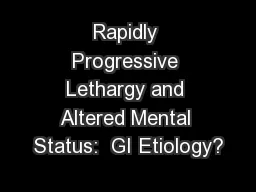

Tim Ridgway MD FACP Associate Professor of Medicine University of South Dakota Sanford School of Medicine A 63 year old female presents with increasing lethargy and altered mental status over the previous 2 days She also complained of nonspecific colicky abdominal pain over the past 3 weeks ID: 711550
Download Presentation The PPT/PDF document "Rapidly Progressive Lethargy and Altered..." is the property of its rightful owner. Permission is granted to download and print the materials on this web site for personal, non-commercial use only, and to display it on your personal computer provided you do not modify the materials and that you retain all copyright notices contained in the materials. By downloading content from our website, you accept the terms of this agreement.
Slide1
Rapidly Progressive Lethargy and Altered Mental Status: GI Etiology?
Tim Ridgway MD FACP
Associate Professor of Medicine
University of South Dakota Sanford School of MedicineSlide2
A 63 year old female presents with increasing lethargy and altered mental status over the previous 2 days. She also complained of nonspecific colicky abdominal pain over the past 3 weeks. On the evening prior to admission, she noted shaking chills. The following day she developed increasing shortness of breath, prompting evaluation locally and transfer to our facility.Slide3
HypertensionAnxietyOsteoarthritis with predominant knee involvement
No surgeries
Past Medical HistorySlide4
Amlodipine 2.5mg dailyOmeprazole 20mg daily (recently started)
Temazepam
30mg nightlyDiclofenac 75mg bid
Paroxetine 40mg daily
Quetiapine
100mg nightly
Losarten-hydrochlorothiazide 100-25mg daily
MedicationsSlide5
Admitted to the Intensive Care Unit appearing acutely ill
Temp 97.6 RR25 BP 87/63 Pulse 101
Oxygen saturation 70% on room air
Lungs:
Tachypneic
with decreased breath sounds bilaterally without wheezes
Cardiac: Hyperdynamic precordium without murmurs. No JVD
Physical ExaminationSlide6
Abdomen: Nondistended
and soft. Bowel sounds present but decreased. No focal tenderness to palpation
Neurologic: Disoriented and minimally responsive. No focal neurologic deficit noted
Physical ExaminationSlide7
WBC 15.7 (90% neutrophils and 24% bands)
Hemoglobin 9.8 g/dl Hematocrit 29%
AST 67 U/L, ALT 49 U/L
Alk
Phos
522 U/L, Total bili 3.8 mg/dl
ABG: pH 7.3, pCO2 48mm Hg, pO2 65mm Hg
Bicarbonate 20
meq
/L, Lactate 1.7mmol/L
Electrolytes unremarkable
Creatinine 1.8 g/dl
LaboratorySlide8
Progressive respiratory failure requiring endotracheal intubationProgressive neurologic deterioration leading to unresponsiveness
Marked hypotension requiring
pressor support
Broad spectrum antibiotics started after appropriate cultures
Clinical CourseSlide9
Abdominal Ultrasound: Contracted gallbladder with wall thickening and pericholecystic
inflammatory changes suggestive of
cholecystitis. No gallstones or CBD stones seen. CBD 4.2mm diameter
CT Chest: Mild pleural effusions bilaterally and bilateral lower lung infiltrates suggestive of bilateral pneumonia
CT Head: No focal abnormality noted
ImagingSlide10
CT ABDOMENSlide11
CT ABDOMENSlide12
CT ABDOMENSlide13
ERCPSlide14
CT IMMEDIATELY AFTER ERCPSlide15
CT IMMEDIATELY AFTER ERCPSlide16
CT IMMEDIATELY AFTER ERCPSlide17
Gradual clinical improvement leading to weaning of pressors
and
extubationStreptococcus Intermedius
bacteremia
Liver abscess developed in area adjacent to
pnumobilia
-percutaneous drainage performed
HOSPITAL COURSESlide18
F/U EGD on 11th hospital day: Severely deformed gastric
antrum
and deep necrotic ulcer along anterior wall of duodenal bulbBiopsies negative for H. Pylori
Biliary stent removed
Operative intervention-15
th
hospital day
HOSPITAL COURSESlide19
Fistulous connection between duodenal bulb and left lateral segment of liver (hepatoduodenal
fistula)
Liver abscess adjacent to gallbladderLeft lateral segment abscess/mass
OPERATIVE FINDINGSSlide20
Drainage of liver abscessCholecystectomy
Repair of duodenal ulcer/fistula with a Graham patch
Open hepatic segmentectomy (segment 3)
OPERATIVE INTERVENTIONSlide21
Liver segment: Liver parenchyma with abscess/fistula tract (containing fecal/vegetable materialLeft lateral segment mass: Necrotic tissue with acute and chronic inflammation
Gallbladder: Mild chronic
cholecystitis with adjacent focal abscess formation
PATHOLOGYSlide22
Bilateral septic emboli to lungs-resolvedRespiratory failure-resolved
Acute Kidney Injury-resolving
Central Nervous System dysfunction-resolvedLiver abscesses-resolved
Discharge on hospital day 30
IV
Vancomycin
additional 2 weeks
POST OPERATIVE COURSESlide23
Completed course of Vancomycin
Eventual bilateral Total Knee
ArthroplastyFull recovery!
OUTPATIENT FOLLOW-UPSlide24
< 20 cases reported in the medical literatureGI bleeding most common presentation
Most are diagnosed by histologic exam of endoscopic biopsies or at surgery
This is the only known case which presented as sepsis
HEPATODUODENAL FISTULASlide25
NSAIDS highest risk for perforation and penetrationFew cases resolve without surgical management
Complications include GI bleeding and hepatic abscess
HEPATODUODENAL FISTULASlide26
A thick gallbladder wall seen on imaging is a nonspecific findingChronic NSAID use-BEWARE!
Pneumobilia
without previous intervention-SERIOUS!Sepsis presentation-you have a narrow window of opportunity
TAKE HOME POINTS